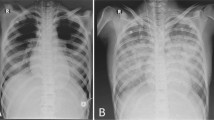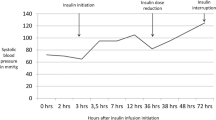Abstract
Calcium channel blockers (CCBs) are responsible for a substantial portion of the mortality associated with cardiovascular medication overdose cases. Amlodipine, a dihydropyridine CCB, can cause prolonged hypotension in overdose. This report describes a severe amlodipine overdose case that was refractory to multiple therapeutic approaches. A 53-year-old male presented after ingesting eighty 10 mg amlodipine tablets in a suicide attempt. The patient was initially managed with calcium boluses, glucagon, multiple vasoactive agents, lipid emulsion infusions and hyperinsulinemic euglycemic therapy. Methylene blue boluses were initiated when hypotension persisted despite conventional treatments. Refractory hypotension prompted the use of plasmapheresis in an attempt to lower serum amlodipine levels. Finally, the patient was placed on extracorporeal membrane oxygenation (ECMO) to maintain perfusion while the effects of the amlodipine ingestion dissipated. Following an episode of asystole and pulseless electrical activity prior to the start of ECMO, the patient suffered an anoxic brain injury and suspected herniation prompting the family to withdraw medical care. There is limited evidence in the literature describing the refractory treatment modalities utilized in this patient. This report is unique as it describes the clinical course of a patient when a multitude of unique treatments were combined.
Similar content being viewed by others
References
Mowry, J. B., Spyker, D. A., Brooks, D. E., Zimmerman, A., & Schauben, J. L. (2016). 2015 Annual Report of the American Association of Poison Control Centers’ National Poison Data System (NPDS): 33rd Annual Report. Clinical Toxicology (Philadelphia, PA), 54, 924–1109.
Harris, N. S. (2006). Case records of the Massachusetts General Hospital. Case 24-2006. A 40-year-old woman with hypotension after an overdose of amlodipine. New England Journal of Medicine, 355, 602–611.
Jang, D. H., Nelson, L. S., & Hoffman, R. S. (2011). Methylene blue in the treatment of refractory shock from an amlodipine overdose. Annals of Emergency Medicine, 58, 565–567.
Burkes, R., & Wendorf, G. (2015). A multifaceted approach to calcium channel blocker overdose: A case report and literature review. Clinical Case Reports, 3, 566–569.
Meaney, C. J., Sareh, H., Hayes, B. D., & Gonzales, J. P. (2013). Intravenous lipid emulsion in the management of amlodipine overdose. Hospital Pharmacy, 48, 848–854.
Shepherd, G., & Klein-Schwartz, W. (2005). High-dose insulin therapy for calcium-channel blocker overdose. Annals of Pharmacotherapy, 395, 923–930.
St-Onge, M., Dubé, P. A., Gosselin, S., Guimont, C., Godwin, J., Archambault, P. M., et al. (2014). Treatment for calcium channel blocker poisoning: A systematic review. Clinical Toxicology (Philadelphia, PA), 52, 926–944.
Mann, S. (2014). Management of calcium channel blocker overdose. Emergency Nurse, 21, 36–39.
Walter, F. G., Frye, G., Mullen, J. T., Ekins, B. R., & Khasigian, P. A. (1993). Amelioration of nifedipine poisoning associated with glucagon therapy. Annals of Emergency Medicine, 22, 1234–1237.
Engebretsen, K. M., Kaczmarek, K. M., Morgan, J., & Holger, J. S. (2011). High-dose insulin therapy in beta-blocker and calcium channel-blocker poisoning. Clinical Toxicology (Philadelphia, PA), 49, 277–283.
Greene, S. L., Gawarammana, I., Wood, D. M., Jones, A. L., & Dargan, P. I. (2007). Relative safety of hyperinsulinaemia/euglycaemia therapy in the management of calcium channel blocker overdose: A prospective observational study. Intensive Care Medicine, 33, 2019–2024.
Aggarwal, N., Kupfer, Y., Seneviratne, C., & Tessler, S. (2013). Methylene blue reverses recalcitrant shock in β-blocker and calcium channel blocker overdose. BMJ Case Reports, 2013, 2013.
Ezidiegwu, C., Spektor, Z., Nasr, M. R., Kelly, K. C., & Rosales, L. G. (2008). A case report on the role of plasma exchange in the management of a massive amlodipine besylate intoxication. Therapeutic Apheresis and Dialysis, 12, 180–184.
Tiftik, N., Kiykim, A., Altintas, E., Sezer, K., Doruk, N., Sezgin, O., et al. (2003). Therapeutic plasma exchange for multidrug intoxication: A case report. Journal of Clinical Apheresis, 18, 132–133.
Koschny, R., Lutz, M., Seckinger, J., Schwenger, V., Stremmel, W., & Eisenbach, C. (2014). Extracorporeal life support and plasmapheresis in a case of severe polyintoxication. Journal of Emergency Medicine, 47, 527–531.
Weinberg, R. L., Bouchard, N. C., Abrams, D. C., Bacchetta, M., Dzierba, A. L., Burkart, K. M., et al. (2014). Venoarterial extracorporeal membrane oxygenation for the management of massive amlodipine overdose. Perfusion, 29, 53–56.
Maskell, K. F., Ferguson, N. M., Bain, J., & Wills, B. K. (2017). Survival after cardiac arrest: ECMO rescue therapy after amlodipine and metoprolol overdose. Cardiovascular Toxicology, 17, 223–225.
Daubin, C., Lehoux, P., Ivascau, C., Tasle, M., Bousta, M., Lepage, O., et al. (2009). Extracorporeal life support in severe drug intoxication: A retrospective cohort study of seventeen cases. Critical Care, 13, R138.
Nowycky, M. C., Fox, A. P., & Tsien, R. W. (1985). Three types of neuronal calcium channel with different calcium agonist sensitivity. Nature, 316, 440–443.
Hess, P., Lansman, J. B., & Tsien, R. W. (1984). Different modes of Ca channel gating behavior favoured by dihydropyridine Ca agonists and antagonists. Nature, 311, 538–544.
Spedding, M., & Berg, C. (1984). Interactions between a “calcium channel agonist”, Bay K 8644, and calcium antagonists differentiate calcium antagonist subgroups in K+-depolarized smooth muscle. Naunyn Schmiedebergs Archives of Pharmacology, 328, 69–75.
Son, M. C., & Brinton, R. D. (1998). Vasopressin-induced calcium signaling in cultured cortical neurons. Brain Research, 793, 244–254.
Author information
Authors and Affiliations
Corresponding author
Rights and permissions
About this article
Cite this article
Chudow, M., Ferguson, K. A Case of Severe, Refractory Hypotension After Amlodipine Overdose. Cardiovasc Toxicol 18, 192–197 (2018). https://doi.org/10.1007/s12012-017-9419-x
Published:
Issue Date:
DOI: https://doi.org/10.1007/s12012-017-9419-x




